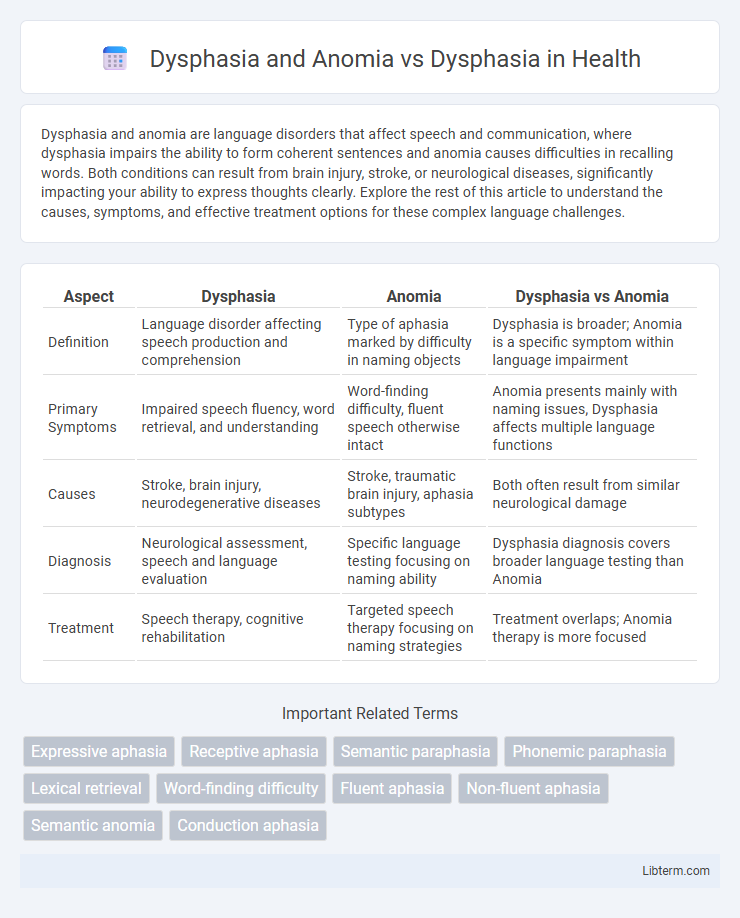Dysphasia and anomia are language disorders that affect speech and communication, where dysphasia impairs the ability to form coherent sentences and anomia causes difficulties in recalling words. Both conditions can result from brain injury, stroke, or neurological diseases, significantly impacting your ability to express thoughts clearly. Explore the rest of this article to understand the causes, symptoms, and effective treatment options for these complex language challenges.
Table of Comparison
| Aspect | Dysphasia | Anomia | Dysphasia vs Anomia |
|---|---|---|---|
| Definition | Language disorder affecting speech production and comprehension | Type of aphasia marked by difficulty in naming objects | Dysphasia is broader; Anomia is a specific symptom within language impairment |
| Primary Symptoms | Impaired speech fluency, word retrieval, and understanding | Word-finding difficulty, fluent speech otherwise intact | Anomia presents mainly with naming issues, Dysphasia affects multiple language functions |
| Causes | Stroke, brain injury, neurodegenerative diseases | Stroke, traumatic brain injury, aphasia subtypes | Both often result from similar neurological damage |
| Diagnosis | Neurological assessment, speech and language evaluation | Specific language testing focusing on naming ability | Dysphasia diagnosis covers broader language testing than Anomia |
| Treatment | Speech therapy, cognitive rehabilitation | Targeted speech therapy focusing on naming strategies | Treatment overlaps; Anomia therapy is more focused |
Understanding Dysphasia: An Overview
Dysphasia is a language disorder affecting speech production and comprehension, often resulting from brain injury or stroke. Anomia, a specific type of dysphasia, primarily impairs word retrieval while other language skills remain intact, distinguishing it from broader language deficits seen in general dysphasia. Understanding dysphasia involves recognizing varied symptoms like impaired grammar, difficulty in sentence formation, and word-finding challenges, which guide targeted speech therapy interventions.
Defining Anomia: Symptoms and Characteristics
Anomia is a specific type of language impairment characterized by difficulty in retrieving words, particularly nouns, despite intact comprehension and fluent speech, often seen in conjunction with dysphasia. Symptoms of anomia include frequent pauses, circumlocutions, and the use of vague terms, reflecting underlying lexical retrieval deficits distinct from broader speech production problems typical of dysphasia. Unlike general dysphasia, which involves impaired comprehension and expressive language abilities, anomia primarily affects word-finding and naming capabilities within verbal communication.
Dysphasia vs Anomia: Key Differences
Dysphasia is a broader language disorder affecting speech production, comprehension, reading, and writing, often resulting from brain injury or stroke. Anomia is a specific type of dysphasia characterized primarily by difficulty in naming objects or retrieving words despite intact comprehension and fluency. The key difference lies in dysphasia's global impact on language functions, whereas anomia is isolated to word-finding impairments.
Common Causes of Dysphasia and Anomia
Dysphasia and anomia often result from neurological damage such as stroke, traumatic brain injury, or neurodegenerative diseases like Alzheimer's. Ischemic or hemorrhagic strokes disrupt the brain's language centers, leading to difficulties in speech production and word retrieval. Anomia specifically highlights impaired lexical access, while dysphasia encompasses broader language processing deficits.
Clinical Presentation: Comparing Language Impairments
Dysphasia manifests as a broad language impairment affecting speech comprehension, production, reading, and writing, often resulting from brain injury or stroke. Anomia, a specific subtype of dysphasia, primarily involves difficulty in word retrieval, causing patients to struggle with naming objects despite intact comprehension and fluency. Clinically, dysphasia presents with widespread deficits, while anomia is characterized by isolated lexical retrieval problems, guiding differential diagnosis and targeted therapy.
Diagnostic Approaches in Dysphasia and Anomia
Diagnostic approaches in dysphasia and anomia involve detailed language assessment focusing on expressive and receptive language abilities, with anomia specifically evaluated through naming tasks to identify word retrieval failures. Neuroimaging techniques such as MRI and CT scans assist in detecting brain lesions predominantly in the left hemisphere's language areas, helping differentiate between general dysphasia and specific anomia. Standardized tests like the Boston Naming Test and the Western Aphasia Battery provide quantitative data on language deficits, guiding targeted therapeutic interventions.
Neurological Basis of Dysphasia and Anomia
Dysphasia involves impaired language processing due to damage in the brain's language centers, primarily the left hemisphere's Broca's and Wernicke's areas, affecting speech production and comprehension. Anomia, characterized by difficulty in word retrieval, is linked to lesions in the left temporal lobe, particularly the middle and inferior temporal gyri, disrupting semantic memory pathways. Both conditions stem from neurological impairments but differ as dysphasia impairs broader language functions, while anomia specifically affects lexical access within the neural language network.
Treatment Strategies and Rehabilitation
Treatment strategies for Dysphasia and Anomia emphasize targeted speech therapy to improve language comprehension and word retrieval, utilizing techniques such as semantic feature analysis and cueing systems. Rehabilitation for Dysphasia focuses on restoring overall language skills through methods like constraint-induced language therapy, while Anomia-specific interventions prioritize exercises that enhance naming abilities and lexical access. Both conditions benefit from individualized therapy plans integrating multidisciplinary support, including cognitive-linguistic training and communication partner education to maximize functional recovery.
Prognosis: Recovery and Long-Term Outcomes
Dysphasia and anomia both impact language abilities, but prognosis differs as anomia primarily involves word retrieval difficulties while dysphasia affects broader language functions. Recovery in dysphasia varies based on lesion size, location, and rehabilitation intensity, often showing gradual improvement over months to years. Long-term outcomes for anomia tend to be more favorable with targeted speech therapy, whereas dysphasia may require comprehensive multidisciplinary intervention for sustained language function restoration.
Living with Dysphasia and Anomia: Patient Support and Resources
Living with dysphasia and anomia requires targeted speech therapy to improve communication skills and enhance language function. Patient support includes access to specialized resources such as language rehabilitation programs, support groups, and assistive communication devices. Comprehensive care often involves multidisciplinary teams including speech-language pathologists, neurologists, and occupational therapists to address the cognitive and emotional challenges faced by individuals.
Dysphasia and Anomia Infographic

 libterm.com
libterm.com